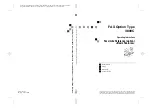
English
4
p )
Do not operate the power tool near flammable
materials.
Sparks could ignite these materials.
Kickback and Related Warnings
Kickback is a sudden reaction to a pinched or snagged
rotating wheel. Pinching or snagging causes rapid stalling
of the rotating wheel which in turn causes the uncontrolled
power tool to be forced in the direction opposite of the wheel’s
rotation at the point of the binding.
For example, if an abrasive wheel is snagged or pinched by
the workpiece, the edge of the wheel that is entering into the
pinch point can dig into the surface of the material causing
the wheel to climb out or kick out. The wheel may either jump
toward or away from the operator, depending on direction
of the wheel’s movement at the point of pinching. Abrasive
wheels may also break under these conditions.
Kickback is the result of power tool misuse and/or incorrect
operating procedures or conditions and can be avoided by
taking proper precautions as given below.
a )
Maintain a firm grip on the power tool and
position your body and arm to allow you to
resist kickback forces. Always hold front and rear
handle for maximum control over kickback or
torque reaction during start-up.
The operator can
control torque reactions or kickback forces, if proper
precautions are taken.
b )
Never place your hand near the rotating
accessory.
Accessory may kickback over your hand.
c )
Do not position your body in line with the
rotating wheel.
Kickback will propel the tool in
direction opposite to the wheel’s movement at the
point of snagging.
d )
Use special care when working corners, sharp
edges etc. Avoid bouncing and snagging the
accessory.
Corners, sharp edges or bouncing have
a tendency to snag the rotating accessory and cause
loss of control or kickback.
e )
Do not attach a saw chain, woodcarving blade or
toothed saw blade on the saw.
Such blades cause
frequent kickback and loss of control.
f )
Do not use a segmented wheel with a peripheral
gap greater than 3/8" (10 mm).
g )
Do not "jam" the wheel or apply excessive
pressure. Do not attempt to make an excessive
depth of cut.
Overstressing the wheel increases the
loading and susceptibility to twisting or binding of
the wheel in the cut and the possibility of kickback or
wheel breakage.
h )
When wheel is binding or when interrupting a
cut for any reason, switch off the power tool and
hold the power tool motionless until the wheel
comes to a complete stop. Never attempt to
remove the wheel from the cut while the wheel
is in motion otherwise kickback may occur.
Investigate and take corrective action to eliminate the
cause of wheel binding.
i )
Do not restart the cutting operation in the
workpiece. Let the wheel reach full speed and
carefully re-enter the cut.
The wheel may bind,
walk up or kickback if the power tool is restarted in
the workpiece.
j )
Support panels or any oversized workpiece
to minimize the risk of wheel pinching and
kickback. Large workpieces tend to sag under
their own weight.
Supports must be placed under
the workpiece near the line of cut and near the edge of
the workpiece on both sides of the wheel.
k )
Use extra caution when making a “pocket
cut” into existing walls or other blind areas.
The protruding wheel may cut gas or water pipes,
electrical wiring or objects that can cause kickback.
Additional Safety Information
•
Use of accessories not specified in this manual is not
recommended and may be hazardous.
Use of power
boosters that would cause the tool to be driven at speeds
greater than its rated speed constitutes misuse.
•
Do not use circular saw blades with this tool.
Serious
injury may result.
•
Avoid bouncing the wheel or giving it rough
treatment.
If this occurs, stop the tool and inspect the
wheel for cracks or flaws.
•
Direct sparks away from operator, bystanders or
flammable materials.
Sparks may be produced while
using a cut-off tool. Sparks may cause burns or start fires.
•
Always use front handle. Make sure the front handle
is securely tightened before use.
The front handle
should always be used to maintain control of the tool at
all times.
•
Never cut into area that may contain electrical
wiring or piping.
Serious injury may result.
•
Clean out your tool often, especially after heavy
use.
Dust and grit containing metal particles often
accumulate on interior surfaces and could create an
electric shock hazard.
•
Do not operate this tool for long periods of time.
Vibration caused by tool action may be harmful
to your hands and arms.
Use gloves to provide extra
cushion and limit exposure by taking frequent rest periods.
•
Never use the weight of the tool to stop
blade rotation.
•
Never leave your cut-off machine unattended if it is
in operating mode.
When your cut-off machine is not in
use, remove the battery pack, make sure the trigger switch
is in the OFF position and lock-off button is engaged.
•
Always wear sturdy boots with non-slip soles and
heavy-duty work gloves when operating your cut-off
machine.
Heavy-duty gloves improve your grip and
protect your hands.
•
Always use NIOSH/OSHA approved respiratory
protection when wet cutting below the
recommended flow rate.
•
Consult and follow any federal, state or local laws or
regulations with respect to dry and wet cutting.







































